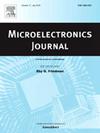A high-precision GSG probe planarization method based on direct current signal
IF 1.9
3区 工程技术
Q3 ENGINEERING, ELECTRICAL & ELECTRONIC
引用次数: 0
Abstract
Since the GSG (ground-signal-ground) probe has three pins, it needs planarization before the wafer test. To ensure the reliability of the RF wafer test, a new high-precision GSG probe planarization method is first proposed based on DC (Direct Current) analysis. The angle-force model of the GSG probe contact and separation process is derived, which is based on the analysis of the collected real-time force and electrical data using a designed force sensing system, and voltage measuring circuit. The results show that when the GSG probe is in contact with the substrate and away from the substrate, the relationship between the angle and force model is a primary function and a quadratic function respectively. The angle of the GSG probe can be obtained by substituting the force of the change points of voltage and resistance into the angle and force model. In addition, the smaller the difference between the minimum force at two-pin contact and three-pin contact of the GSG probe, the smaller the angle of the GSG probe. This method can provide a method and idea for the automatic planarization of GSG probes.
基于直流信号的高精度 GSG 探头平面化方法
由于 GSG(接地-信号-接地)探针有三个引脚,因此需要在晶片测试前对其进行平面化处理。为确保射频晶片测试的可靠性,首先提出了一种基于直流(DC)分析的新型高精度 GSG 探头平面化方法。利用设计的力传感系统和电压测量电路,通过对采集到的实时力和电气数据进行分析,推导出了 GSG 探头接触和分离过程的角力模型。结果表明,当 GSG 探头与基底接触和远离基底时,角度与力模型之间的关系分别是一次函数和二次函数。将电压和电阻变化点的力代入角度和力模型,即可得到 GSG 探头的角度。此外,GSG 探头两针接触点和三针接触点的最小力之间的差值越小,GSG 探头的角度就越小。这种方法可以为 GSG 探头的自动平面化提供一种方法和思路。
本文章由计算机程序翻译,如有差异,请以英文原文为准。
求助全文
约1分钟内获得全文
求助全文
来源期刊

Microelectronics Journal
工程技术-工程:电子与电气
CiteScore
4.00
自引率
27.30%
发文量
222
审稿时长
43 days
期刊介绍:
Published since 1969, the Microelectronics Journal is an international forum for the dissemination of research and applications of microelectronic systems, circuits, and emerging technologies. Papers published in the Microelectronics Journal have undergone peer review to ensure originality, relevance, and timeliness. The journal thus provides a worldwide, regular, and comprehensive update on microelectronic circuits and systems.
The Microelectronics Journal invites papers describing significant research and applications in all of the areas listed below. Comprehensive review/survey papers covering recent developments will also be considered. The Microelectronics Journal covers circuits and systems. This topic includes but is not limited to: Analog, digital, mixed, and RF circuits and related design methodologies; Logic, architectural, and system level synthesis; Testing, design for testability, built-in self-test; Area, power, and thermal analysis and design; Mixed-domain simulation and design; Embedded systems; Non-von Neumann computing and related technologies and circuits; Design and test of high complexity systems integration; SoC, NoC, SIP, and NIP design and test; 3-D integration design and analysis; Emerging device technologies and circuits, such as FinFETs, SETs, spintronics, SFQ, MTJ, etc.
Application aspects such as signal and image processing including circuits for cryptography, sensors, and actuators including sensor networks, reliability and quality issues, and economic models are also welcome.
 求助内容:
求助内容: 应助结果提醒方式:
应助结果提醒方式:


